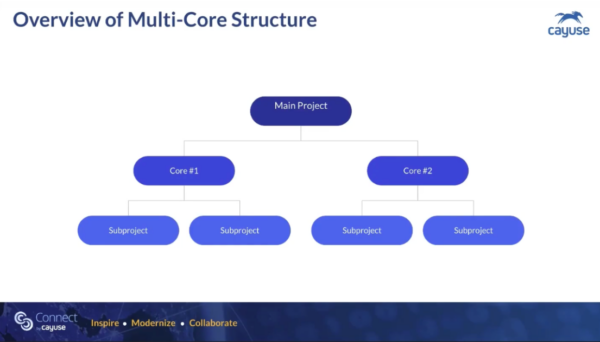Multi-core projects are unique and complex entities within sponsored projects, requiring meticulous organization and diligent oversight. These large-scale endeavors involve multiple interrelated components that stand alone while sharing a common goal.
During our Connect by Cayuse Conference in 2022, we brought together a select handful of expert panelists to discuss how to submit, manage, and coordinate multi-core projects. Our panel included:
- Laura Carson, Research Administrator IV at UC Berkeley
- Paul Below, Director of Grants and Sponsored Programs at St. Jude Children’s Research Hospital
- Kathryn Simpson, Professional Services Consultant at Cayuse
In this blog, we’ll share their valuable insights and best practices for managing large-scale, multi-core research projects efficiently and effectively.
Multi-core projects, defined
Multi-core research projects feature at least two interrelated components linked to a shared theme. Each component must stand on its own; yet, each core must complement the others to achieve an overarching objective.
These multi-component programs may take the form of grants or cooperative agreements and share the following features:
- At least two interrelated components related to a theme, but must stand on their own and complement each other
- Collaboration among the components and Investigators who are taking part
- Synergy among components
- Support as needed for shared resources, generally among two cores (as for center projects and P30s)
A typical multi-core project structure involves one main project with multiple cores and subprojects beneath it. Each core may have a different principal investigator (PI) and managing office, adding complexity to the administration process.

Pre-Award Considerations
Budget Building
The budget-building process is foundational to managing multi-core projects. Each core has an individual budget, so it is crucial to plan with the primary PI on the allocation for each core. Use an organized spreadsheet or Electronic Research Administration (eRA) budget to track changes effectively, ensuring a comparison between budgets and justifications.
At the budgeting stage, you should also:
- Know what you’re going for. What is the amount of the potential award? What is budgeted for each subaward?
- Understand the timeline. Meet with the PI and everyone included in the main core, as well as the core you’re working with directly. Ensure that everyone understands the timeline. What do you need, and by when? What does your central office require in terms of time?
- Respect your subawards. Budgets are always ongoing, so respect your subawards’ time and budget. Share your budget worksheet with everyone, letting them work from the same template to avoid confusion.
- Have templates ready and send them promptly, so you can pull a budget together quickly.
- Keep a master budget spreadsheet to track what’s going on when you pull all components together.
Proposal Submission
The submission process for large-scale projects requires careful planning and management. Here are the panel’s top tips for ensuring a thorough review:
- Act early. Acquire as many parts of the proposal as you can, as early as possible.
- Maintain active communication. Keep open lines of communication with all collaborators and hold regular status update calls.
- Understand the requirements. Do you need justifications, letters of recommendation, or bio sketches? Adopt a way to track these deliverables.
- Is there a time limit? Get each subaward to provide a bare minimum.
- Assess resources. Assess the current state of institutional infrastructure, equipment, lab space, staffing, and other resources.
- Identify the key players. Determine whether key players (RO1 researchers core directors, and support staff) are in place. Have the core directors run a core before, or will they need guidance from someone who has?
- Secure approvals. Institutional support may be needed, especially for projects requiring policy changes. Secure any necessary approvals as early as possible.
- Make a communication plan: How will all the players work together? Will you hold virtual or in-person meetings? How often?
- Use templates: Any templates that can be provided to subawards are helpful, especially if you want your data to be structured in a specific way.
Administrative Considerations
In addition, ensure that you have the following infrastructure in place (as needed):
- Equipment
- Lab space
- Central Office staffing:
- Sponsored Programs
- IRB/IACUC
- Biosafety
- Facilities
Post-Award Process
Once a project is awarded, efficient management is essential. The post-award process includes award setup (including subawards), budget monitoring, reporting, and closeout. Monitoring subawards is a crucial part of this process and often takes a substantial amount of time.
The Research Performance Projects Report (RPPR) is a vital part of the post-award process. It’s important to work with subawards to gather needed information before the RPPR’s due date. Involving the PI in this process can be beneficial as well.
Conclusion
Managing large, multi-core projects can be complex, but with careful planning and organization—not to mention the right tools—you can streamline your processes and ensure overall success.


